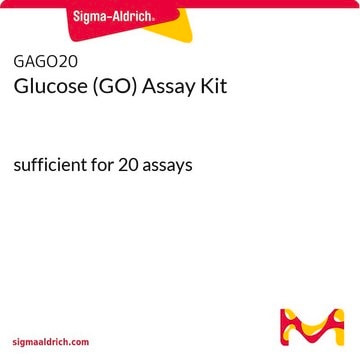Products may be shipped at a different temperature than the recommended long-term storage temperature. If the product quality is sensitive to short-term exposure to conditions other than the recommended long-term storage, it will be shipped on wet or dry-ice. If the product quality is NOT affected by short-term exposure to conditions other than the recommended long-term storage, it will be shipped at ambient temperature. As shipping routes are configured for minimum transit times, shipping at ambient temperature helps control shipping costs for our customers. For more information, please refer to the Storage and Transport Conditions document: https://www.sigmaaldrich.com/deepweb/assets/sigmaaldrich/marketing/global/documents/316/622/storage-transport-conditions-mk.pdf
Wichtige Dokumente
MAK064
Lactat-Assay-Kit
sufficient for 100 colorimetric or fluorometric tests
Synonym(e):
Milchsäure-Assay-Kit
About This Item
Empfohlene Produkte
Verwendung
sufficient for 100 colorimetric or fluorometric tests
Anwendung(en)
cosmetics
food and beverages
Nachweisverfahren
colorimetric
fluorometric
Relevante Krankheit(en)
endocrinological disorders, diabetes; cancer
Lagertemp.
−20°C
Allgemeine Beschreibung
Anwendung
Eignung
Prinzip
Ersetzt durch
Signalwort
Danger
H-Sätze
Gefahreneinstufungen
Resp. Sens. 1 - Skin Sens. 1
Lagerklassenschlüssel
10 - Combustible liquids
Flammpunkt (°F)
188.6 °F - closed cup
Flammpunkt (°C)
87 °C - closed cup
Hier finden Sie alle aktuellen Versionen:
Analysenzertifikate (COA)
Die passende Version wird nicht angezeigt?
Wenn Sie eine bestimmte Version benötigen, können Sie anhand der Lot- oder Chargennummer nach einem spezifischen Zertifikat suchen.
Besitzen Sie dieses Produkt bereits?
In der Dokumentenbibliothek finden Sie die Dokumentation zu den Produkten, die Sie kürzlich erworben haben.
Artikel
Warburg effect enhances glucose to lactate conversion in tumor cells, regardless of oxygen levels; impacting cancer metabolism since 1924.
-
How is shipping temperature determined? And how is it related to the product storage temperature?
1 answer-
Helpful?
-
-
How can I determine the shelf life / expiration / retest date of this product?
1 answer-
If this product has an expiration or retest date, it will be shown on the Certificate of Analysis (COA, CofA). If there is no retest or expiration date listed on the product's COA, we do not have suitable stability data to determine a shelf life. For these products, the only date on the COA will be the release date; a retest, expiration, or use-by-date will not be displayed.
For all products, we recommend handling per defined conditions as printed in our product literature and website product descriptions. We recommend that products should be routinely inspected by customers to ensure they perform as expected.
For products without retest or expiration dates, our standard warranty of 1 year from the date of shipment is applicable.
For more information, please refer to the Product Dating Information document: https://www.sigmaaldrich.com/deepweb/assets/sigmaaldrich/marketing/global/documents/449/386/product-dating-information-mk.pdfHelpful?
-
-
What is the formula for the MAK064D Lactate standard?
1 answer-
The standard provided in the MAK064-1KT Lactate Assay Kit is L-Lactic acid sodium salt (CAS 867-56-1) dissolved in water. It contains no other components or cofactors.
Helpful?
-
-
Since the L-(+)-Lactate standard is not a pure solution of sodium L-(+)-Lactate in water or buffer, which are the cofactors present in the standard?
1 answer-
The standard provided in this kit is L-Lactic acid sodium salt (CAS 867-56-1) dissolved in water. There are no other components or cofactors present in the standard.
Helpful?
-
-
What is the concentration range of lactate for this? The description says typical sensitivity is 0.001 - 10 mM, but in the product info the standard curve for colorimetric detection appears to go to a max. concentration of 0.0002µM (10nmol in 50µL sample)
1 answer-
The lower limit of detection is calculated by dividing the lowest concentration standard by the maximum sample volume. The higher limit of detection is determined by dividing the highest concentration standard by the minimum sample volume.
For the higher limit of detection, take the 10 nmol standard and divide by 1 uL to get 10 mM. For the lower limit of detection, take 0.02 nmol and divide by 50 uL to get 0.0004 mM. We have reached out to our vendor to discuss the range calculation further, as it seems there is some conflicting information.
Helpful?
-
-
Can this kit be used on conditioned media containing phenol red?
1 answer-
If the sample being measured is the cell culture supernatant, the required volume is 20 uL. This is diluted with a total volume of 100 uL of the various kit reagents. The presence of phenol red may impact the results. It would be up to the end user to determine suitability.
Helpful?
-
-
On which enzymatic reaction is this kit based? Does pyruvate in the sample interfere with the assay?
1 answer-
This kit utilizes lactate oxidase to measure lactate. In sufficient amounts pyrivate may impact the results. This can be corrected by subtracting any background from the blank value. See page 3 in the kit protocol provided in the link below:
https://www.sigmaaldrich.com/deepweb/assets/sigmaaldrich/product/documents/411/763/mak064bul.pdfHelpful?
-
-
What is the Department of Transportation shipping information for this product?
1 answer-
Transportation information can be found in Section 14 of the product's (M)SDS.To access the shipping information for this material, use the link on the product detail page for the product.
Helpful?
-
-
Can I make up my own Lactate standard to use with Product MAK064, Lactate Assay kit?
1 answer-
Unfortunately, no. If you run the 100 mM L-(+)-Lactate standard (MAK064D) that comes with the kit, you should get good results. However, if you just use, for example, a solution of sodium L-(+)-lactate dissolved in water or buffer, you probably won't get good results. There are cofactors present in biological samples and in the L-(+)-Lactate standard that comes with the kit (which is not a pure solution of sodium L-(+)-Lactate in water or buffer). If such a "homemade" standard solution were to be spiked with a biological sample or the kit standard, the calculations would be more complicated, but the assay should work.
Helpful?
-
Active Filters
Unser Team von Wissenschaftlern verfügt über Erfahrung in allen Forschungsbereichen einschließlich Life Science, Materialwissenschaften, chemischer Synthese, Chromatographie, Analytik und vielen mehr..
Setzen Sie sich mit dem technischen Dienst in Verbindung.


